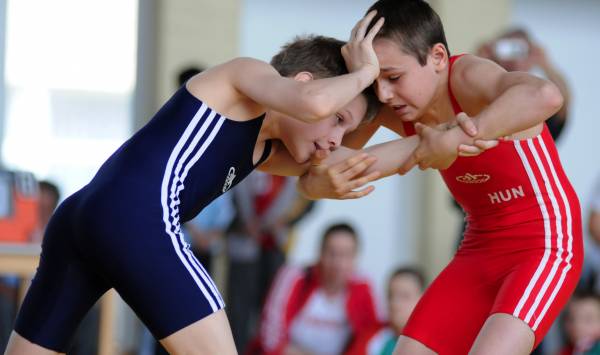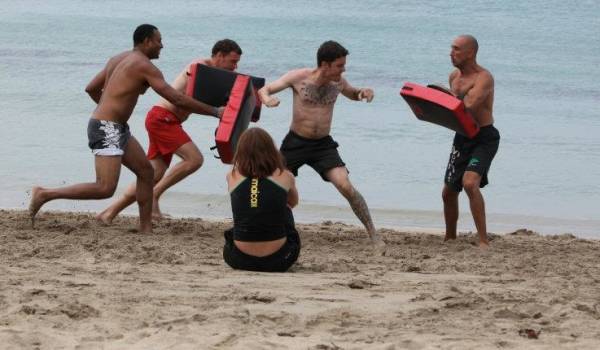This article is for people new to grappling arts or thinking of taking the first step through the door of a gym. The purpose is to not only give you technical insight, but also to put grappling into the larger perspective of human fighting interaction, whether it’s based in play or real-life violence.
When we humans fight, we hit each other, we kick each other, and we grab each other. In a nutshell, that is fighting, and you will see some variation of these things whether you are watching people fight on the street in Philadelphia, in the ring in Bangkok, or on a playground in Iowa.
There are specific patterns to fighting that cross cultural boundaries and cross the boundaries of time. Martial traditions from all over the world document variations of the hitting and grabbing themes over thousands of years.
Mongolian wrestlers honing their skills in Ulaanbaatar, Mongolia.
Cultural and Natural Influences
While naturally there are cultural influences that create variations, the basic ideas are always the same. Hit and grab. If someone has the potential to hit us with a fist or an object, our tendency is to either hit back, make distance, or grab and attempt to neutralize and control the attacker.
When we close the distance between ourselves and another person, we grab to stop him from hitting us. We also grab to control him so he cannot run away. We grab to change the position of the fight by throwing someone, taking him to the ground, or pinning him up against a wall or a car.
“[I]n the end, the game is always the same: grab the other person and manipulate him with the goal of control and possibly submission.”
We can grab offensively to twist a limb or control our opponent, and we can also apply strangulation techniques to render our opponent unconscious. Generally, in untrained fighting, we see grabbing methods used mostly to control the other person’s movement in space or to take the fight to a place where even greater control is possible.
Over time, the human impulse to grapple became codified into systems of techniques and tricks. These systems became martial traditions, but also, because of the relatively safe nature of grappling, these systems have often developed a sporting outlet where people can practice their skills competitively without doing harm.
Arts like judo, Brazilian jiu jitsu, wrestling, sambo, and sumo are all popular styles of grappling the world over, but there are a number of smaller regional styles that share similar qualities like glima, Mongolian wrestling, and others. But in the end, the game is always the same: grab the other person and manipulate him with the goal of control and possibly submission.

Three Common Patterns
There are some common archetypal patterns to each form of grappling, whether it’s untrained or trained. The three most common patterns are:
- Controlling our opponent’s torso
- Controlling one or more of our opponent’s appendages
- Using a surface (like the ground or a wall) to control our opponent
Often we use some combination of all three. For the sake of clarity, I’m using a simple arm control clinch and the mount position as ways to illustrate these concepts.
When we close the distance between ourselves and an opponent, what we call clinching, the most direct way is through control of the torso. In fighting, you see a tendency for people to bring their upper body close to the opponent’s upper body and grab the opponent’s torso or neck (perhaps to pin him or her against a wall or to hold as they punch). Sometimes you will see a tackle to the lower abdomen or legs. These are all variations of controlling the torso. Again, we are limiting our opponent’s movement so he or she cannot easily step farther or closer to us and hit us unpredictably.
But the problem still remains – while our foe is now less mobile, he can still strike us with his limbs and even his head. The intuitive solution to this problem is to try to control the striking limb by grabbing it or pinning it to something. Someone is hitting you with a stick? You will try to grab either the arm or the stick. But this is easier said than done.
Once you have contact with your opponent’s torso, place your hand at the shoulder of your opponent and slide outward from there to gain and keep control of a wildly swinging limb. Trying to catch the hand or wrist is simply too difficult. I suggest stopping at the elbow because from there you neutralize the movement of the whole limb. If you slide down to the wrist, you can control it somewhat, but because the elbow and shoulder are both still free to move, it can be easy for the opponent to free the hand from your grip, unless you are pinning it to the ground or a wall.
The Mount Position
If you have siblings or have ever been in a schoolyard fight, you know the position. You both wrestle around and fall to the ground. One person gets on top of the other and mayhem ensues.
The person on top has the torso of the opponent pinned between his body weight and the ground. The person on bottom has limited movement so he can’t generate full power to strike or push, and he cannot easily get up or make distance to escape. The person on bottom often cannot reach the face of the person on top, whereas the person on top can easily strike the opponent, and with full bodyweight behind the blows.
From the top person’s perspective, it is crucial to keep tight to your opponent. The person on bottom will try to push you off, hit you, grab your arms, or turn away from you. If you keep your weight on your opponent and focus on staying tight, you will more easily neutralize his activities. If you are on top of someone, it helps to think of space as your enemy.
“If you keep your weight on your opponent and focus on staying tight, you will more easily neutralize his activities.”
That said, you need to train yourself to have a certain amount of relaxation in your body. You don’t want to go totally limp, but instead be like a heavy blanket on top of your opponent. Imagine how much harder it is to push a water mattress off of you than it is to push a firm mattress. This concept not easy at first, but as you progress in your training, this will be a valuable skill and you will develop more quickly if you have this ability and awareness.

Practicing combatives on the beach at a MovNat retreat in Thailand.
Final Thoughts
This article isn’t meant to encourage people to go out and fight, but to provide some technical insight into what happens when people do fight. If you are newly involved in a combat sport, these concepts and tips will help educate your practice. Being aware of natural human fighting archetypes can be a powerful tool to help you bridge the gap between your natural tendencies and technique.
“Sometimes there is a large gap between the ideas you might have and what is taught in a martial arts class, and this chasm can make learning difficult.”
A new student walks in the dojo or academy door having instinctive, experiential, and cultural ideas about what happens in a fight. Sometimes there is a large gap between the ideas you might have and what is taught in a martial arts class, and this chasm can make learning difficult. If it doesn’t look like and doesn’t feel like fighting to you, then you face the double challenge of learning new reflexes and also having your view of violent human interaction reshaped.
From my perspective as a teacher, a simple approach is to recognize that people hit each other and grab each other in specific ways and provide a more technical version of that to my new students. “Here’s what you already know about fighting. Let’s clean that up a bit.”
Once you are made aware of your natural reactions and technical improvements to those, it’s much easier to move on to things that take more training and repetition to absorb.
More Like This:
- The 5 Critical Responsibilities of the Grappling Student
- Why MovNat Benefits Athletes in all Sports
- Move Your Body, Move Your Brain: Training for Neuroplasticity
- New on Breaking Muscle Today
Photos 1 and 2 courtesy of Shutterstock.
Photo 3 courtesy of MovNat.






